Mary Magdalene, the Rebel
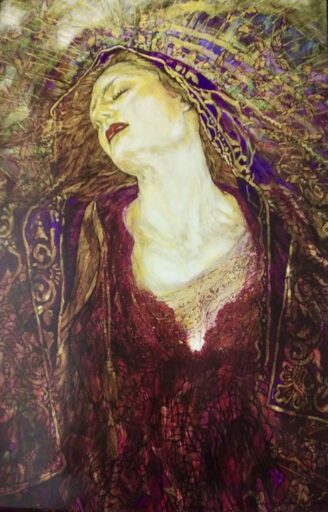
Many of us feel like the black sheep of the family. We might struggle to relate, especially if we rejected our Christian upbringing. We might feel like we don’t fit in, a square peg in a round hole. We might feel judged for not having the same beliefs as our family, for shedding the stories our family tells about itself.
We might have explored other cultures, other religions and other ways of being as I did. This might put another layer of misunderstanding onto an already complex relationship. Our family might feel abandoned and betrayed by us, misunderstood and judged for who they are. And we will undoubtedly feel the same.
I have always felt different. I have spent decades feeling like a black sheep, an anomaly, a step out of rhythm with those around me. I have always felt on the outside, looking in. I searched the world for a sense of belonging, for a religion or spiritual path that resonated with me.
I wanted to understand why I am who I am, and how I got here. I needed to make connections through time and give me a secure footing within the unfolding saga of time. I needed roots through time.
My story is not all that unusual. Western culture is fractured from their roots. We don’t live with generations of our extended family. We might live thousands of miles away from where our family first started. We might have lost that sense of culture and any traditions that were originally passed through families. Severed from our roots we long to belong. We long to feel that deep sense of place, of being anchored to the land of our ancestors through generations of people who remain ever present.
My search for a sense of belonging has shaped my life. I have searched for people of like mind, for community and most importantly to be seen, heard and acknowledged. It has taken me a lifetime to make sense of this longing within me.
The whole trajectory of my life has been motivated by the story of my genetic inheritance. My search for belonging has taken me all over the world. I couldn’t understand myself without learning about the spiritual path of women. Only then could I put my own life into perspective and find a greater meaning to the trajectory my life has taken.

We all long to feel a sense of belonging, to feel a sense of connection and to feel worthy. We all long to be seen, heard and acknowledged, just as we are. We all long to be loved for who we truly are – warts and all!
We all want to feel understood, even when others don’t agree with our opinion. We all want to belong, to feel a needed part of our community. We all want to be part of something larger than ourselves.
Being seen, heard and acknowledged is a basic human need. It is a way we receive love. Otherwise we feel worthless, undeserving, not enough. We feel invisible. We feel unloved and unlovable.
We are all told early in life that to receive approval and love we need to conform. We are asked to be a certain way and to act a certain way in order to receive approval and love we need. If we don’t our parents might complain or get annoyed with us, or worse withdraw their love.
But what happens when a persona is chosen for us? What happens when we are given the masks and told to play a part we don’t like? What do we do? Do we play along and try to make the best of it? Or do we refuse? Do we risk disapproval, conflict? Do we risk being rejected because we won’t play along?
We’ve all been through this in our lives. We’ve all been caught in situations where people expected us to act a certain way and we complied. We played along. We played our part.
But then we’ve probably had situations where we refused to. We put our foot down. We chose not to laugh along, not to condone behaviour we found dishonest or disrespectful or that dishonoured ourselves or others.
We’ve had moments in our life when we had a choice. What would we do? How would we react?
Some of us conform. We follow the script we’ve been taught. We spend our entire lives trying to please others, trying to fit in, trying to be something we’re not. Some of us rebel. We throw caution to the wind, cast aside the conditioning of our childhoods and throw away the script we were given. We begin to improvise, using all our wits to stay safe.
These moments can become pivotal. They give us the option to cast aside the masks we’ve been given and decide who we want to play for ourselves. We might discover the frightening beauty in being ourselves, warts and all. We might choose to pursue our authentic self, to express the truth of who we are; the good, the bad and the ugly!
This takes real courage. Will we be liked? Are we enough? Are we what they expected? Will we let others down? Or will we be judged, criticised, ridiculed? Will we be shut down?
But what does this have to do with Mary Magdalene?
The Watch Tower
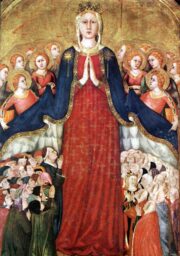
Why did her name change from Mary of Bethany and Mary of Magdala to Mary Magdalene? My personal theory is that Jesus gave her the title Magdalene. He gave his other disciples nick names and titles, so why not Mary?
Jesus chose names to represent the personalities of the disciples: “The names of the twelve apostles are these: first, Simon, who is called Peter, and Andrew his brother; James the son of Zebedee, and John his brother” (Matthew 10:2) and “James the son of Zebedee and John the brother of James (to whom he gave the name Boanerges, that is, Sons of Thunder)” (Mark 3:17).
This Madonna della Misericordia was painted in 1333 by Lippo Memmi is in the Chapel of the Corporal Duomo Orvieto.
In ‘The Grail Enigma’ Laurence Gardiner believes Magdalene could be a metaphor for someone of high status in the community, high standing like a tower or castle, who was a community guardian, a “watchtower of the flock” (Micah 4:8).
In ‘Mary Magdalen: Myth and Metaphor’ Susan Haskin concluded: “Interpreters since the time of Jerome have suggested that Mary was called Magdalene because of her stature and faith, i.e. because she was like a tower: ‘Mary Magdalene received the epithet ‘fortified with towers’ because of her earnestness and strength of faith, and was privileged to see the rising of Christ first even before the apostles’.”
Susan Haskin is referring to the Prophecy of Micah in the Book of Micah of the Old Testament. In about 700 BCE, the Hebrew prophet Micah recorded an amazing prophecy known as The Prophecy of Micah (The Prophecy of Micah 4:8-11).
 The Prophecy of Micah describes a woman as the personification of the nation of Israel. She was crying over her deceased king and rabbi before being sent, defiled and defamed, into foreign exile, eventually to be rescued. Despite it all she gathers nations as disciples and teaches.
The Prophecy of Micah describes a woman as the personification of the nation of Israel. She was crying over her deceased king and rabbi before being sent, defiled and defamed, into foreign exile, eventually to be rescued. Despite it all she gathers nations as disciples and teaches.
According to W. Muss-Arnolt ‘On Semitic Words in Greek and Latin’ and Miranda Shaw ‘Sketch of the World’ her name comes from the Hebrew word Migdal (meaning tower or fortress). In Aramaic this was Magdala meaning tower or elevated, great, magnificent. Another theory of her name is that she lived in Magdala, a town between Jerusalem and Bethlehem. There are 59 sites with the root migdol, meaning tower or watchtower in Hebrew, across the eastern and southern Levant.
This fresco is Mary Magdalene by Giacinto Brandi (1621-1691)
Another interpretation of the tower was referencing the tower overlooking the flock of sheep destined for sacrifice at the Temple of Jerusalem. These sheep were the chosen ones, considered to be fulfilling a sacred role for the people. The one in the watchtower was charged with keeping them safe from harm, looking out over the flock to prevent attack from wild animals. Perhaps Jesus chose to call her Migdal as a nod to this passage, giving her the prophetic forewarning of her coming and her stature.
Hamartolos
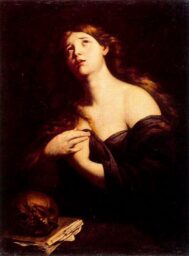 By now I hope you are discovering how much of a renegade Mary Magdalene was. She was truly a rebel in her own time. Considering she travelled with Jesus and is described as a financial supporter of his ministry Mary Magdalene was independently wealthy and a financial supporter of Jesus. She spent her money where she saw fit. Although it wasn’t unusual for women to travel with a religious teacher, it was scandalous. It is hard to imagine how Mary was able to be amongst Jesus’ followers without being married to one of the disciples.
By now I hope you are discovering how much of a renegade Mary Magdalene was. She was truly a rebel in her own time. Considering she travelled with Jesus and is described as a financial supporter of his ministry Mary Magdalene was independently wealthy and a financial supporter of Jesus. She spent her money where she saw fit. Although it wasn’t unusual for women to travel with a religious teacher, it was scandalous. It is hard to imagine how Mary was able to be amongst Jesus’ followers without being married to one of the disciples.
But this was not acceptable way for a Hebrew woman to live.
Mary Magdalene was most likely the unnamed “woman in the city, who was a sinner” anointed Jesus’ feet with ointment (Luke 7:36-50). The word sinner was translated from the Greek hamartolos. This is the word interpreted to call Mary Magdalene a prostitute.
This image is a seventeenth-century oil painting of ‘The Penitent Magdalene’ by the Italian Baroque artist Andrea Vaccaro.
Harmartolos referred to someone who had transgressed Civil Jewish Law, rather than a moral sinner. In ‘When God Had a Wife: the rise and fall of the Sacred Feminine in the Judeo-Christian Tradition’ Lynn Picknett and Clive Prince translate hamartolos as an archery term meaning to miss the target that “applied to Jews who failed to keep the Law and also those who needn’t observe it simply because they were not Jewish”.
Mary Magdalene was called hamartolos, an outcast. Mary had abandoned Jewish civil law and had become an outsider of Jewish ways. She was a strange woman who did not follow the Jewish customs or the Hebrew religion. This made her hamartolos in the eyes of Jewish culture.
In ‘Magdalene Mysteries: The Left-Hand Path of the Feminine Christ’ Seren Bertrand and Azra Bertrand M.D. say hamartolos meant Mary Magdalene was “an outsider, one who exists beyond the conventional bounds of society, who is forbidden, and other.” This word hamartolos was also used for both Jesus and his mother Mary.
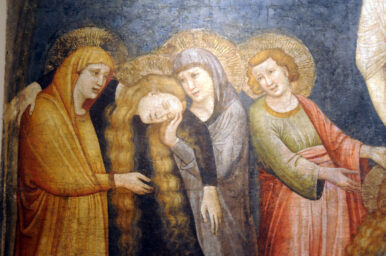
From what we know of Mary Magdalene so far, were there reasons to call her hamartolos?
Hamartolos could be used for a woman who chose not to marry, someone who was not paying taxes, or a woman who has chosen to study the Torah or being part of discussions of sacred text. Hamartolos could be used for a woman who was going against the expectations of her society and Jewish law.
According to Jewish civil law, women had to have their hair covered and wear a veil in public. Yet Mary dried Jesus’ feet with her hair so her hair was unbound or at least uncovered. This was enough of a sin for her head to be shaved!
This image is a detail of the Three Marys at the foot of the Cross is from a fresco of ‘The Crucifixion’ painted by the Master of the Urbino Coronation, Italian (Riminese), active about 1340–1380.
For Mary of Magdala to travel so freely suggests she was not married. In first century, Palestine it would have been unthinkable for an unmarried woman to travel unaccompanied with a religious teacher and his followers. More perplexing still is the closeness she shared with Jesus.
I believe that what made Mary Magdalene hamartolos in the eyes of Jewish civil law was that she was educated in the scriptures. This knowledge was strictly for men. Women were prohibited from studying the Torah or even learning to read its script. Mary Magdalene was outside the laws of her society.
This would have been grounds for adultery for an unmarried woman. Mary Magdalene was the only woman in the Bible not defined by her relationship to any man as his daughter, mother, wife or daughter. If Mary Magdalene had married, obedience to her husband was required from her as part of her religious obligation.
Her testimony was considered legally invalid so she couldn’t receive a divorce. Leaving her husband was considered a sin in Jewish civil law, an offence. It was almost unthinkable. If she had chosen not to marry, she was also still a sinner according to Jewish civil law.
According to Judaic Law this was enough to make her an outcast or a sinner. Mary was most definitely transgressing Jewish civil law. She disregarded social convention and religious obligation. That is what made her a sinner. She was a renegade in her own time – a woman who chose to walk the road less travelled and raised a few eyebrows along the way.
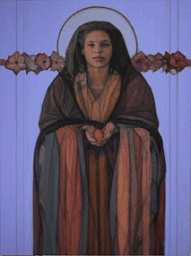
In Mary Magdalene’s time, women were prohibited from studying the Torah or even learning to read its script. Mary Magdalene had proven herself worthy of accessing sacred wisdom. According to Judaic Law this was enough to make her an outcast or a sinner.
Mary Magdalene lived outside the laws of her society where this knowledge was strictly for men. Mary Magdalene most definitely was transgressing Civil Jewish Law. And that’s what made her a sinner. She was a renegade in her own time – a woman who was choosing to walk the road less travelled…and raising a few eyebrows along the way!
In Mary Magdalene’s time the rules for women were strict. To bend or flout these rules was not just breaking a Jewish moral code of conduct, it was breaking the Civil Jewish Law.
In this portrait of ‘Mary Magdalene Invitation to Love’ by Janet McKenzie.
Consequences could be harsh and spontaneous such as being stoned to death. Mary Magdalene was not satisfied with these ill-fitting clothes that did not take her womanliness into account.
Mary Magdalene was a renegade in her own time – a woman who chose to walk the road less travelled and raised a few eyebrows along the way.
Men did not like her. Mary Magdalene questioned their authority and their power. Mary Magdalene stood her ground as an equal to any man. Mary Magdalene was looking for her identity beyond what society forced upon her. She searched for acceptance, for love, for her god.
Forging Her Own Path
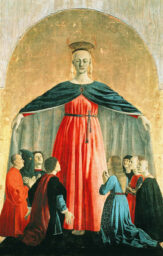
Mary Magdalene was the watch tower, a threshold between the worlds, between spirit and matter. She was a carrier of the Divine Feminine in a world. She acted as a vessel of the sacred, transmitting fierce compassion and creative power. She was a living, magical doorway, a portal of divine love.
Mary Magdalene fulfilled the roles of teacher, prophetess, mystic and preacher. But she was denied the recognition first by Jesus’ disciples and ultimately by the Orthodox Church. She was regarded as inessential, insignificant, a minor player in Jesus’ ministry and the early followers who created the early Church.
Mary Magdalene was looking for her identity beyond what society forced upon her. She searched for acceptance, for love, for her god.
This is a detail from Piero della Francesca’s Polyptych of the Misericordia, 1460-62.
Mary Magdalene searched for her own personal connection with the god of her ancestors, exploring beyond what others told her. She searched for a new way of being that was more authentically true for her. In the process, Mary disrupted the social narrative of her culture.
Mary Magdalene rebelled against the social cues and rules of her society. Mary Magdalene threw caution to the wind and headed off into unknown territory, learning as she went.
Mary Magdalene became hamartolos, an outcast, an outsider. Mary Magdalene had abandoned Jewish civil law and had become an outcaste of Jewish ways. She was a strange woman, a hamartolos, who did not follow the Jewish customs or the Hebrew religion.
Mary Magdalene was put in her place and was written out of the script as soon as was practicable. She died in relative obscurity, disappeared into the shadows. This isn’t new. It is so old most people see it as normal, even expected treatment of women.
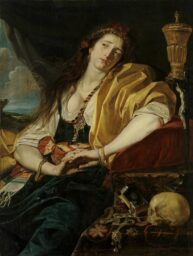
Mary Magdalene was a seeker. She was not satisfied with the wisdom of other people. Mary Magdalene wanted to know all. She felt their insubstantial emptiness and wanted to know for herself. Mary Magdalene knew there was more out there she could access, if only she figured out how to see for herself.
Mary Magdalene was not satisfied listening to the direct experiences of others. Mary Magdalene wanted to receive divine messages and visions directly from spirit for herself.
Mary Magdalene was searching for knowledge that exists behind the words of the holy books, the words of the prophets. She wanted to understand the truth of it. She sought the full meaning that existed for these prophets who tried to condense their experience into words.
This Mary Magdalene is by Abraham Janssens in 1762 and is housed in the Bavarian State Painting Collections. She is dressed in her wealth, surrounded by jewels, silks, fruit, and a golden ointment jar. I find her expression hard to interpret, her head tilted and her crying eyes staring off to the right. She has her skull and crucifix nearby, emblems of death and redemption.
The wisdom of others were hand-me-downs that did not fit her figure. They were designed to fit a man’s thinking, carefully shaped to fit a man’s contours and sit snugly around his thinking. This included the expectations and prejudices of his times, where women were not fit to sit with a man, where a woman’s testimony was considered legally invalid.
Mary Magdalene was not satisfied listening to the direct experiences of others. Mary Magdalene wanted to receive divine messages and visions directly from spirit for herself.
Mary Magdalene was searching for knowledge that exists behind the words of the holy books, the words of the prophets. She wanted to understand the truth of it. She sought the full meaning that existed for these prophets who tried to condense their experience into words.
Mary Magdalene had proven herself worthy of accessing sacred wisdom.
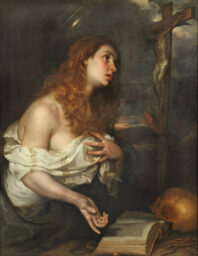
Mary Magdalene proved herself worthy to know the all. She was taught secret doctrine. Jesus shared how to access Spirit, how to communicate directly with God or a messenger of God.
Mary Magdalene transcended the words in the holy books and sought to experience Spirit for herself. Mary Magdalene transcended the wisdom of the other apostles because they stayed limited by words, by man-made laws and by the narrow thinking of their culture.
The apostles were unable to cast aside the prejudices of their culture, to see beyond gender and class, to the essential nature within us all. This was what Mary Magdalene strove to do. Mary Magdalene discovered everything she searched for had been within her all along. The source of her longing was only a heartbeat away! Mary Magdalene reclaimed her essential nature. She became fully realised – anthropos.
This ‘Penitent Mary Magdalene’ after Cerezo Mateo the younger Spanish painter from 1637-1666.
Mary Magdalene stopped following the status quo, stopped believing the Pharisees. She stopped obeying her parents and those in her community who demanded she return to her old ways. Mary Magdalene stopped reading from the script. In order to seek her truth, she followed the great teachers of her time: first John the Baptist then with Jesus.
Mary Magdalene sought their wisdom, but in the process she became their equal. They fell for her, in all her glory, as a woman who was their equal in every way. These men saw her worth. These men realised all that she could be and all that she held within her. She was no longer merely a student, sitting at the foot of her Rabboni. They placed her upon her throne and worshipped her as the living earthly manifestation of Sophia.
It was with the love of Jesus that she became fully realised. She stepped fully into her own inner authority and became a wise teacher in her own right. Mary Magdalene had discovered the hard way that those who could convince the masses that only they held the truth, only they could mediate between spirit and the people, held the power. Rebelling against their authority was a death sentence. Rebelling demanded the greatest courage to sacrifice everything in the search for truth.
Rebel with a Cause
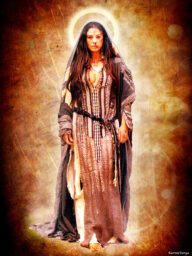 Rebelling is rife with danger and hardships. Without a script we are forced to make it up as we go along. We don’t know exactly where we’re going. The finish is up for grabs. There’s no certainty except that everything will be uncertain.
Rebelling is rife with danger and hardships. Without a script we are forced to make it up as we go along. We don’t know exactly where we’re going. The finish is up for grabs. There’s no certainty except that everything will be uncertain.
Will we be enough without the mask? We may feel waves of self-loathing, fear, doubt, anywhere we feel unheard, unseen and unsupported, anytime we feel unloved, unappreciated, unapproved of. We may feel unqualified; a fraud or an imposter. We may feel small, feel less, feel less than ourselves, less beautiful, feel disempowered, incompetent, unworthy or not enough.
Mary Magdalene’s legacy was so powerful and so strong it has survived two thousand years of persecution and derision by the Church. This is a woman who could not be silenced! Her voice reverberates through the ages.
This evocative image of ‘Saint Mary Magdalene’ is by karmievarya. She looks like she’s walking calmly away having caused absolute bedlam behind her.
Mary Magdalene’s life mirrors our own. We all seek connection and belonging and for meaning helped us make sense of my life. We all need to be seen, heard and acknowledged.
Mary Magdalene must have raised some eyebrows in her lifetime. As far as Judaic tradition was concerned a good woman was a subservient one. Mary Magdalene stood out in a world where she was not meant to be seen or heard.
Mary Magdalene did not stand by quietly waiting to be seen. She burst in amongst the men, unannounced and unwelcome. She was not a woman who sat idly by, seeing the men and doing her womanly duties.
Repeatedly, Mary Magdalene rebelled. Mary Magdalene was not like most women. Unlike so many women of her time, Mary Magdalene railed against the patriarchal system and the misogyny of her culture. Despite pressure to behave otherwise, Mary Magdalene disregarded social convention and religious obligation. Mary Magdalene cast aside the conditioning of her Jewish upbringing and the script that told her who she had to be.
 Mary Magdalene threatened to destabilise the status quo and the men around her tried to silence her. A powerful assertive woman, Mary Magdalene stood her ground and spoke her truth. Even when her voice quivered and her knees shook.
Mary Magdalene threatened to destabilise the status quo and the men around her tried to silence her. A powerful assertive woman, Mary Magdalene stood her ground and spoke her truth. Even when her voice quivered and her knees shook.
They threatened her, taunted her and tried to shut her down. Mary Magdalene broke all the conventions of her time. Mary Magdalene stood firm in order to be seen, heard and acknowledged not only in her own lifetime but in the establishing church.
Mary Magdalene overcame all through sheer willpower. What would have made most women shrink back into the shadows and not speak another word only made Mary Magdalene more determined to have her say.
This Mary Magdalene with Alabaster Jar is by Esoterica Zosimoto.
Mary Magdalene stood firm against the disciples and more radically, against convention. Peter tried to force her out of the conversation, to put her back in her place, to exclude her. Mary Magdalene refused. Mary Magdalene spoke up. Mary Magdalene was seen, heard and acknowledged.
Her story is one of tenacious survival and standing firm against pressure to conform. Mary Magdalene refused to back down. She refused to follow the script of her generation’s gender roles. Mary Magdalene refused to shrink back into the model of womanhood society prescribed. This was actually a story of resistance!
I love this new story. It makes my heart sing. I resonate with it because I see myself in Mary Magdalene the rebel.
Mary Magdalene was not self-effacing or timid. Mary Magdalene was rooted in her integrity and did not shy away from speaking her truth. With great clarity she calmly faced down opposition and those who accused her of dishonesty. She did not back down.
Mary Magdalene remained unaffected by the external pressure to be anything other than the truth of who she was. Over and over Mary Magdalene asserted her will – to be seen, to be heard and to be acknowledged as just as worthy as any man. This made her intimidating.
Mary Magdalene was a woman before her time. Mary Magdalene came to balance the power dynamic between the sexes and reintroduce the need for recognition and acceptance of the divine feminine within her own staunchly patriarchal society.
Mary Magdalene models a new way of being that asks us to keep our heart open without losing our integrity and clear boundaries. The clearer our boundaries are the more love can flow without unnecessary entanglements.
 To stand up, stand out and make a difference we are asked to sacrifice our comfort, security and stability. We expose ourselves to attack. It can be a death sentence if we step so far out of the accepted norms that we become a threat to the establishment. This was the case for both Jesus and Mary Magdalene.
To stand up, stand out and make a difference we are asked to sacrifice our comfort, security and stability. We expose ourselves to attack. It can be a death sentence if we step so far out of the accepted norms that we become a threat to the establishment. This was the case for both Jesus and Mary Magdalene.
To live this life, to lead the life of an outcast, a renegade, a hamartolos flouting society’s norms, we need to find what Mary Magdalene found – a deep inner belonging, a deep inner peace and a deep love that spanned all dimensions and forms, including death.
Mary Magdalene stood fearless in the face of adversity and did not flinch when the unimaginable came to pass. Mary Magdalene was a renegade in her own time – a woman who chose to walk the road less travelled and raised a few eyebrows along the way.
Mary Magdalene was looking for her identity beyond what society forced upon her. She searched for acceptance, for love, for her god. Mary searched for her own personal connection with the God of her ancestors, exploring beyond what others told her.
Mary Magdalene searched for a new way of being that was more authentically true for her. In the process, Mary disrupted the social narrative of her culture. She rebelled against the social cues and rules of her society.
Mary Magdalene’s story is not new to us. It is deeply, intimately familiar. It is your story and my story. Remembering our story, seeing these threads running from one woman to the next, generation to generation, age upon age is deeply healing.
By restoring Mary Magdalene to her rightful place as an early leader of the church we can restore all women. We rip off the mask that has been forced on her for the last two thousand years and we begin to see the true face of Mary Magdalene.
 Let us remember. Let us remember the divine feminine, not only the divine masculine. Let us remember that we are the embodiment of the divine feminine and the female aspect of God. We have lost our self-belief and our rightful place in the story of our civilization. We have lost our inner authority as female counterparts to an equally strong masculine counterpart.
Let us remember. Let us remember the divine feminine, not only the divine masculine. Let us remember that we are the embodiment of the divine feminine and the female aspect of God. We have lost our self-belief and our rightful place in the story of our civilization. We have lost our inner authority as female counterparts to an equally strong masculine counterpart.
Let us reimagine who Mary Magdalene was. Let us invite her to step out of the shadows and help us remember an authentic version of an empowered woman. Let us restore the divine feminine to its rightful place.
Only by remembering can we reclaim our roots. We reclaim the old original path that Jesus taught. We reclaim The Way: the true teachings of Jesus as embodied by Mary Magdalene in the south of France where her teachings lived on.
This image called ‘The Still Point — Five Were Wise’ is by Michael Malm. It reminds me of the path women once tread together into the Mystery.
And make no mistake- Mary Magdalene was a magnificent woman! She has been remembered for two thousand years! She continues to inspire, to support and assist women of all faiths all over the world. Mary Magdalene offers us her incredible example to follow. It is time to step into our true power and use it for the benefit of all. It is time to stand up, stand out, and make a difference!

Mary Magdalene is dangerous.
She would not conform.
We have all been shamed for feeling too much. We are made to feel like there was something wrong because we felt more than what people around us were comfortable with.
This is part of our collective wounding in all of us. This ability to feel so much is our strength, as women. It is divinely beautiful to be able to experience the whole gamut of emotion. You are not too much, never too much.
Mary Magdalene shows us how to love hard, feel deeply, ask often, and express our needs and desires. She took up too much space with her voice, her laughter, her wisdom, her sexuality. Her presence is palpable, even two thousand years later.
This mixed media work called ‘Magdalena’ is by Lisbeth Cheever-Gessaman (She who Is).
Mary Magdalene was not ashamed of her body. Her wisdom was rooted in the ancient wisdom of the ancient feminine ways. She was devoted to love, and the Way of Love as a lived spiritual practice demonstrated by Jesus.
Mary Magdalene did not allow what others thought control her. Mary Magdalene caused upheaval with her persistence. She refused to pipe down, to stay silent and small and malleable to the will of the disciples. She wanted to be seen, heard, and acknowledged. She would not stop for anyone.
Mary Magdalene invites us to think for ourselves, to feel it all, to honour the full spectrum of consciousness, and to love our beautiful bodies. Mary Magdalene invites us to express our truth with honesty and integrity. She asks us to stop being afraid of our emotions, our intuition, our needs and desires.
Feature Image: ‘Axis Bold as Love’ by George Yepes
